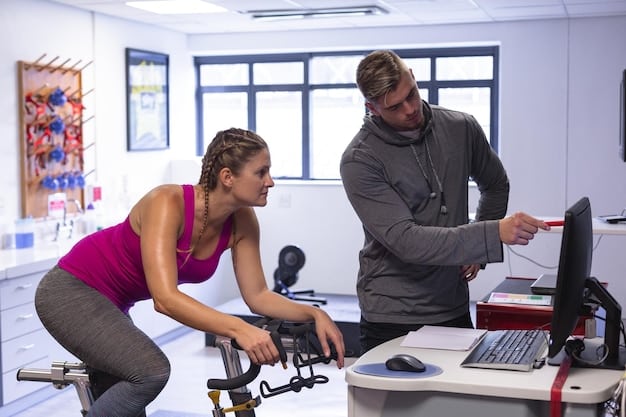The Latest in Sports Injury Prevention: Tech & Techniques

The latest developments in sports injury prevention involve cutting-edge technologies like wearable sensors, AI-driven analytics, and personalized training programs, combined with advanced techniques in rehabilitation and recovery to keep athletes performing at their best.
The world of sports is constantly evolving, and with it, the methods for keeping athletes healthy and on the field. Discover the **latest developments in sports injury prevention: new technologies and techniques** that are revolutionizing how teams and individuals approach training, recovery, and overall well-being.
Advanced monitoring systems
The use of advanced monitoring systems has become increasingly prevalent in sports, offering a wealth of data that can be used to prevent injuries before they occur. These systems provide real-time insights into an athlete’s physical condition, workload, and biomechanics, allowing for personalized training and recovery strategies.
Wearable Technology
Wearable technology, such as smartwatches, heart rate monitors, and GPS trackers, provides continuous data on athletes’ physiological responses during training and competition. This data includes heart rate variability, sleep patterns, and activity levels, which can be used to identify signs of fatigue or overtraining.
Force Plates and Motion Capture
Force plates and motion capture systems are used in biomechanical analysis to assess movement patterns and identify imbalances or weaknesses that could lead to injury. These systems measure ground reaction forces and joint angles, providing valuable information for optimizing technique and reducing the risk of injury.
- Real-time Feedback: Wearable sensors offer immediate feedback, helping athletes adjust their form and intensity to prevent strain.
- Data-Driven Decisions: Coaches can analyze data to make informed decisions about training loads, rest periods, and rehabilitation programs.
- Personalized Training: Monitoring systems enable customized training regimens that address individual needs and weaknesses.
- Early Detection: These tools can detect subtle changes in performance or physiology that may indicate an impending injury.
Advanced monitoring systems are transforming the way sports teams approach injury prevention. By leveraging real-time data and biomechanical insights, coaches and trainers can create personalized training programs that minimize the risk of injury and optimize performance.

AI and data analytics in injury prediction
Artificial intelligence (AI) and data analytics are playing an increasingly important role in sports injury prevention. By analyzing vast amounts of data, AI algorithms can identify patterns and risk factors that may be difficult for humans to detect, leading to more accurate injury predictions and targeted prevention strategies.
Predictive Modeling
AI algorithms can be trained on historical injury data, performance metrics, and physiological data to create predictive models that estimate an athlete’s risk of injury. These models can identify specific risk factors and provide insights into the likelihood of different types of injuries.
Machine Learning Techniques
Machine learning techniques, such as neural networks and decision trees, can be used to analyze complex datasets and identify nonlinear relationships between variables. This allows for a more nuanced understanding of injury risk and the development of more effective prevention strategies.
AI and data analytics offer powerful tools for predicting and preventing sports injuries. By leveraging these technologies, teams and athletes can take a proactive approach to injury management, reducing the risk of time lost due to injury and improving overall performance.
Personalized training programs
Personalized training programs are a cornerstone of modern sports injury prevention. Recognizing that each athlete has unique needs, strengths, and weaknesses, these programs are tailored to the individual to optimize performance while minimizing the risk of injury.
Individualized Assessments
Personalized training programs begin with comprehensive assessments of an athlete’s movement patterns, strength, flexibility, and physiological characteristics. These assessments identify imbalances and weaknesses that can be addressed through targeted interventions.
Adaptive Training Protocols
Adaptive training protocols adjust training loads and exercises based on an athlete’s response to training. This ensures that athletes are challenged appropriately without being pushed beyond their limits, reducing the risk of overtraining and injury.
Personalized training programs are revolutionizing the way athletes train and compete. By tailoring training interventions to the individual, these programs can optimize performance, minimize injury risk, and promote long-term athletic success.

Advances in rehabilitation techniques
Effective rehabilitation is crucial for athletes recovering from injuries. Advances in rehabilitation techniques are helping athletes return to play faster and with a lower risk of re-injury. These techniques focus on restoring strength, flexibility, and function while addressing the underlying causes of the injury.
Targeted Exercises
Rehabilitation programs now incorporate targeted exercises that address specific muscle weaknesses and imbalances. These exercises are designed to restore proper movement patterns and function, helping athletes return to their pre-injury level of performance.
Manual Therapy
Manual therapy techniques, such as massage, joint mobilization, and soft tissue release, can help reduce pain and improve range of motion during rehabilitation. These techniques are often used in conjunction with exercise to promote healing and restore function.
- Accelerated Recovery: Modern rehabilitation techniques speed up the healing process and reduce time spent off the field.
- Reduced Re-injury Risk: By addressing underlying issues, athletes are less likely to experience a repeat injury.
- Improved Performance: Comprehensive rehabilitation programs can enhance strength and flexibility, leading to better performance upon return to play.
- Holistic Approach: These techniques consider the athlete’s overall well-being, promoting mental and physical health during recovery.
Advances in rehabilitation techniques are transforming the way athletes recover from injuries. By incorporating targeted exercises, manual therapy, and other advanced modalities, rehabilitation programs are helping athletes return to play stronger and with a lower risk of re-injury.
Nutrition and recovery strategies
Nutrition and recovery strategies are integral to sports injury prevention. Proper nutrition provides the building blocks for tissue repair and optimal function, while effective recovery strategies help athletes recover from the demands of training and competition.
Optimal Diet
A balanced diet that includes adequate protein, carbohydrates, and healthy fats is essential for supporting tissue repair and reducing inflammation. Athletes may also benefit from specific nutrients, such as omega-3 fatty acids and antioxidants, which can help reduce muscle soreness and promote recovery.
Rest And Sleep
Adequate rest and sleep are crucial for muscle recovery and overall health. Athletes should aim for at least 7-9 hours of sleep per night to allow their bodies to repair and regenerate.
Optimal nutrition and recovery strategies are essential for preventing sports injuries. By prioritizing these elements, athletes can stay healthy, perform at their best, and achieve their athletic goals.
Psychological factors in injury prevention
Psychological factors play a significant role in sports injury prevention. Athletes who are stressed, anxious, or fatigued are more likely to experience injuries. Addressing these psychological factors can help reduce the risk of injury and improve overall performance
Stress Management
Stress management techniques, such as mindfulness, meditation, and deep breathing exercises, can help athletes cope with the pressures of training and competition. These techniques can reduce muscle tension and improve focus, reducing the risk of injury.
Mental Preparation
Mental preparation, including visualization and positive self-talk, can help athletes improve their confidence and focus, reducing the risk of injury. By mentally rehearsing movements and visualizing success, athletes can improve their performance and reduce the likelihood of errors that could lead to injury.
| Key Point | Brief Description |
|---|---|
| 📊 Monitoring Systems | Wearable tech provides real-time data for personalized training and early injury detection. |
| 🧠 AI Analytics | AI models analyze data to predict injury risks and optimize prevention strategies. |
| 💪 Personalized Training | Tailored programs address individual needs and prevent injuries. |
| 🌱 Nutrition & Recovery | Proper diet, rest, and sleep are crucial for tissue repair and preventing injuries. |
Frequently Asked Questions
▼
Common sports injuries include sprains, strains, fractures, dislocations, and concussions. These injuries can occur in various sports due to overuse, trauma, or poor technique.
▼
Wearable technology monitors athletes’ physiological data, such as heart rate and sleep patterns, helping coaches identify fatigue and adjust training accordingly.
▼
Proper nutrition supports tissue repair and reduces inflammation, essential for preventing injuries. A balanced diet helps athletes recover faster and maintain peak performance.
▼
Mental preparation reduces stress and improves focus, lowering the risk of injury. Techniques like visualization and positive self-talk enhance confidence and performance.
▼
Advances in rehabilitation include targeted exercises, manual therapy to restore strength and flexibility, and techniques to address muscle imbalances, facilitating faster and safer returns to play.
Conclusion
The field of sports injury prevention is rapidly evolving, thanks to technological advancements and innovative techniques. By embracing these developments, athletes can minimize their risk of injury and maximize their performance potential.





